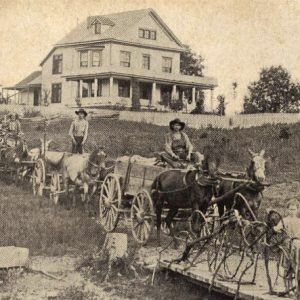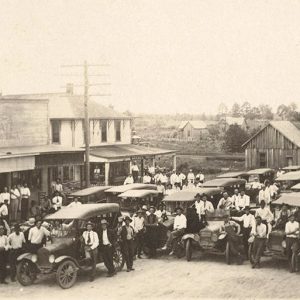calsfoundation@cals.org
Grannis (Polk County)
| Latitude and Longitude: | 34º14’26″N 094º20’06″W |
| Elevation: | 938 feet |
| Area: | 7.93 square miles (2020 Census) |
| Population: | 496 (2020 Census) |
| Incorporation Date: | October 23, 1899 |
Historical Population as per the U.S. Census:
|
1810 |
1820 |
1830 |
1840 |
1850 |
1860 |
1870 |
1880 |
1890 |
1900 |
|
– |
– |
– |
– |
– |
– |
– |
– |
– |
– |
|
1910 |
1920 |
1930 |
1940 |
1950 |
1960 |
1970 |
1980 |
1990 |
2000 |
|
– |
– |
– |
224 |
193 |
185 |
177 |
349 |
507 |
575 |
|
2010 |
2020 |
|
|
|
|
|
|
|
|
|
554 |
496 |
|
|
|
|
|
|
|
Grannis is located on U.S. Highway 71 in southern Polk County. Like many of the cities of southwestern Arkansas, Grannis began as a railroad depot and grew with the development of the timber industry, turning later to the fruit and poultry industries.
The heavily wooded slopes of the Ouachita Mountains were uninviting to the cotton farmers who first settled the area, and no landowners appear in records of the Grannis vicinity prior to 1893. The oldest monument to any human presence in the region is a tombstone on a hilltop that is now the location of the Grannis cemetery. The name of the traveler buried there has been erased by weather, but the year 1881 is still legible on the monument. A sawmill and planer were built near the incipient cemetery in the 1880s, and a post office was established in June 1883. The post office was named Leon Station, but the reason for that name has been forgotten. James Poe purchased land near the sawmill in 1893, and Mary L. Woods also became a landowner in the area in 1895.
In 1896, the Kansas City, Pittsburg and Gulf Railroad (now the Kansas City Southern) built a line south from Mena (Polk County) to transport timber from the sawmill at Leon Station and others like it in the area. Arthur Stilwell, owner of the railroad, named the depot at Leon Station “Grannis” to honor a railroad official of that name, and the name of the post office was changed the following year. A city began to grow around the sawmill and depot, and Grannis was incorporated in October 1899.
Even when the area was cleared of trees, the rocky soil was unfit for cotton, so landowners began to plant orchards of apple and peach trees. They also planted berry bushes, grapevines, and melon patches. A two-room schoolhouse was built around 1909, and by 1912, Grannis had six stores, two hotels, a livery stable, two planing mills, two custom mills, and three churches. The Bank of Grannis opened in 1919. A Ford dealership began operation in Grannis in 1926.
In 1938, the Grannis Canning Company began to market canned fruits, featuring blackberries and other fruits from the area. Around 1952, Clift and Dorothy Lane began processing chickens in their home. They later bought the old railroad depot to house their growing poultry business. They added a rendering plant in 1962 and a hatchery in 1968. The company had become one of the largest in the state after acquiring Arkansas Valley Industries but was engulfed in debt. The company refused to sell out to Tyson Foods and, instead, took out a loan that Stephens, Inc. purchased and sold to Tyson. After Lane Poultry went into bankruptcy, Tyson was permitted to take the stock, and it dissolved the company in 1986.
Gillham Dam was built between 1963 and 1975, creating Gillham Lake on the Cossatot River. Many displaced residents relocated to Grannis at that time. The city of Grannis received federal funds to build a new water system in 1972, and a new post office was opened in early 1975.
Grannis gained national notoriety in 1975 when several families gathered in a house in the city expecting the imminent return of Jesus Christ. Abandoning jobs and property, they existed upon the supplies from a store one of the family members owned. Several weeks later, local authorities intervened to return several children in the group to classes in the public school. The next year, the waiting adults were removed from the house because of their failure to pay the mortgage on the property during their vigil.
Around the same time, Grannis received attention of a different kind when it embraced 238 Vietnamese refugees and other refugees from Southeast Asia, many of whom had previously been housed at Fort Chaffee following their escape from Vietnam.
A tornado in 1979 damaged the school in Grannis. As a result, the school was closed and the school district consolidated with Gillham (Sevier County). In 1981, children in Grannis began attending schools of the Wickes (Polk County) school district. Another tornado in 1999 damaged a poultry farm near Grannis.
In addition to the Tyson plant, Grannis in the twenty-first century is home to a pizza restaurant, a Baptist church, and a Mormon praise temple. Many workers are involved in the cattle industry or the lumber industry—Weyerhaeuser maintains a large pine plantation near Grannis. Children in Grannis attend schools of the Wickes (Polk County) school district. The population of Grannis as of the 2010 federal census is more than eighty percent white, with about a quarter of the population identified as Hispanic. The census lists no Asians, but reports sixty-eight residents as “some other race.”
For additional information:
Apple, Betty, et al. “Grannis, Arkansas, 100 Years Old, September 4, 1999; The History of Grannis.” Mountain Signal 5 (October 1999): 15–17.
Reed, Roy. “Americans, Vietnamese at Grannis Adjusting to Strangeness in New Life.” Arkansas Gazette, October 3, 1976, p. 24A.
Spillman, Brenda. “Grannis Residents Wonder How Neighbors Went Astray.” Arkansas Gazette, November 3, 1975, pp. 1A–2A.
Steven Teske
Encyclopedia of Arkansas History & Culture
 Grannis Fruit
Grannis Fruit  Grannis Street Scene
Grannis Street Scene  Polk County Map
Polk County Map 




The school at Grannis was long associated with the school at Gillham. There were Grannis members on the Gillham School Board, including my father, John Hinson. Grannis students attended Gillham High School starting in grade 7. After the 1979 tornado destroyed Grannis Elementary School, the Gillham District built a new elementary school on the campus at Gillham. Feeling slighted, the residents of Grannis decided to realign themselves with the Wickes district. In the fall of 1981, students from Grannis reported to school at Wickes for the first time.
I’d like to add a detail that may be missing regarding refugees who lived in Grannis in the late 1970s. There were three Laotian families and several Hmong (Ethnic Laotian) families who arrived directly to Grannis from refugee camps in Thailand, in August 1976. We were flown on a commercial flight from Thailand and arrived in Dallas, Texas, and traveled by bus to Grannis. The Laotian and Hmong families were sponsored by Lane Poultry and had trailer home housing, food, and jobs with Lane Poultry once they arrived. There were two American women who arrived from Little Rock who tried to teach English to the adults and children inside their trailer home. I believe they were teaching English to refugee families as part of their college degree program; they could have been there helping us as part of a government grant program. I’m not sure. My family is grateful for the help we received after arriving in this country. We have fond memories of the months we stayed in Grannis. My family and the other two Laotian families moved to Fort Smith in 1977 to be near other Laotian families who arrived there earlier. My family has mainly stayed in the Southwest region of the country, specifically Arkansas, Oklahoma, Kansas, and Texas. The Hmong who arrived with us to Grannis moved farther away to other northern parts of the country in 1977. We have not kept in contact with them.